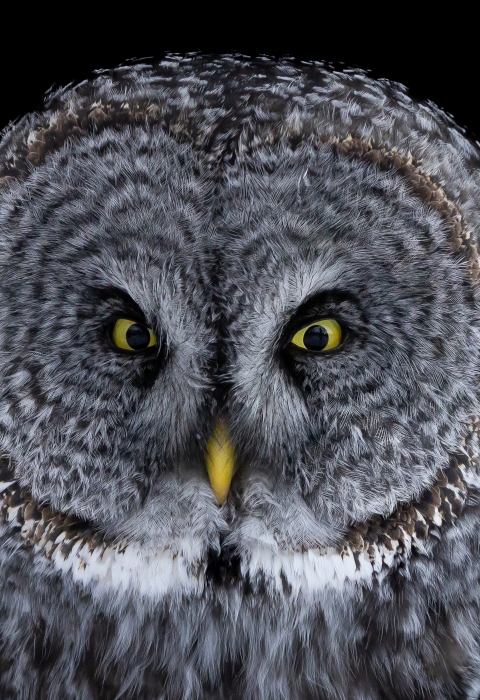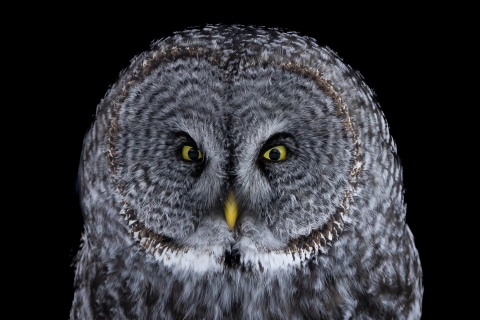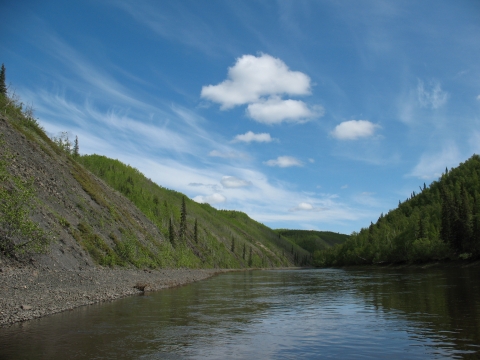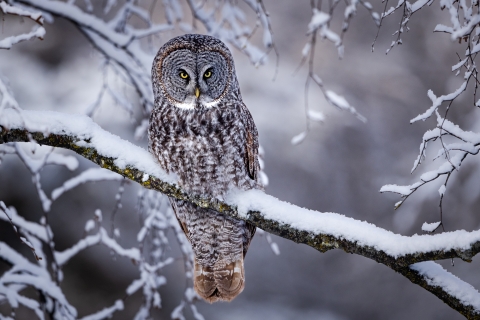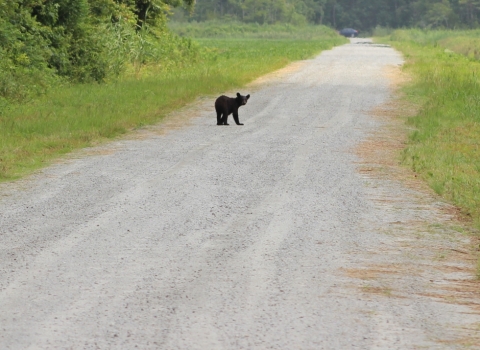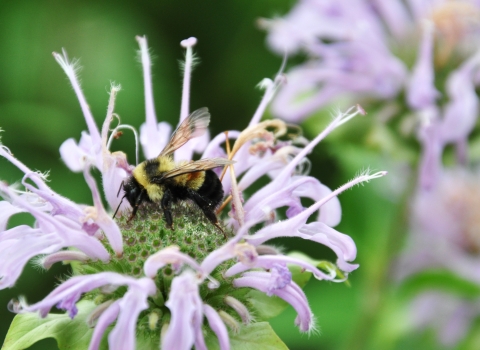Each June, biologists monitor birds along the Kanuti River as it winds just south of the Arctic Circle, through Alaska’s boreal forest and the Kanuti National Wildlife Refuge. They join thousands of scientists and volunteers across the continent in conducting an annual “Breeding Bird Survey,” or BBS, to track migratory bird populations. While BBSs are typically done by car, the refuge has no roads to access the survey, so biologists travel by boat from their administrative cabin on the Kanuti River. Chris Harwood, avian biologist at Kanuti Refuge, recalls some favorite feathered encounters from these remote expeditions.
In some years, the river gods reward you (albeit fleetingly) for getting up at 12:30 AM and braving a frigid, two-hour boat trip in the predawn darkness.
As a wildlife biologist who has done thousands of avian surveys on Yukon Delta and Kanuti National Wildlife Refuges over the last 30 years, I’ve had many opportunities to make observations of not only common birds and behaviors, but also a fair number of uncommon species and rarely observed behaviors.
Chris Harwood starting the Kanuti Lake BBS along the Kanuti River in the morning June light of 03:00 AM.
Point count surveys offer ample opportunities to see something cool yet fleeting. Breeding Bird Surveys (BBS) are a type of point count survey in which the observer travels along a route during the early morning hours during peak bird activity, pausing at 50 specific points for three minutes and recording all bird species seen or heard.
A bonus of the Breeding Bird Survey: you’ll never miss a good sunrise.
However, because point counts are precisely timed and bird activity wanes throughout the morning, a surveyor cannot dawdle. If one observes a “good” bird or behavior, one cannot simply linger and savor the observation for minutes on end; rather, one must pack up quickly and move on to the next point, no matter how tempting the avian delight.
So, it is bittersweet when I spy a rare bird during a survey and must either leave it behind following a timed count, or boat quickly by one seen between points as it stares from the riverbank.
Perhaps no species has mocked me more during the BBS than the great gray owl. Uncommon and spectacular regardless of where it’s found, observing a great gray owl is one of nature’s treats. Merely getting a fleeting glimpse of this stunner would be a cause to celebrate, yet the owl often offers a generous gift by remaining in place and allowing the lucky birder to savor its magnificence and rarity!
Traveling through great gray owl country
Kanuti National Wildlife Refuge conducts two BBSs along the Kanuti River every June. The “Kanuti Canyon BBS” begins at the Refuge’s western border and runs about 25 miles upriver through the canyon. The landscape here is atypical from the rest of the refuge’s boreal forest and wetlands: high, sheer cliffs, aspen groves, and steppe bluffs of sage and juniper. Likewise, this stretch of river is home to birds rarely found in the rest of the refuge, or even in all of Alaska: Townsend’s solitaire and yellow-bellied flycatcher.
The Kanuti River Canyon
About 50 miles upriver of the canyon the “Kanuti Lake BBS” route begins, with some 30 river-miles of typical boreal forest habitats: mixed spruce-birch forest, muskeg, oxbows, and drawn-down lake meadows. This is great gray owl country, and a stretch of the river that is amazingly reliable for spotting the elusive bird.
Boreal forest along the edge of the Kanuti River.
This was likely one of the owl pairs we heard regularly duetting near Kanuti Lake cabin in spring 2022.
This close to the Arctic Circle, June mornings come early for the BBS, with the sun rising (did it ever set?!) around 3 AM. While boating downriver to start the Kanuti Lake route in 2016, 2018, and 2021, we each year observed a great gray owl at 02:45 AM in the exact same snag along the river. “The Snag” became a landmark on our surveys, and we even detected likely the same bird a few hours later at 4 AM as we covered the survey points.
Do you realize how tempting it is to just savor that owl for the entire three-minute count and ignore scanning for other birds!? Unfortunately, I only have a few intermittent seconds to appreciate the encounter in the dim pre-dawn before we zoom off upriver. Maybe “BBS” actually means “Birding bitter sweetness” and not “Breeding Bird Survey” when it comes to great gray owls…
Such were the typically blurry photos (and of a nesting female no less!) we took circa 2011 with only our “SuperZoom” camera feature to aid us as we discreetly boated by on the Kanuti River. This riverbank birch snag nest was actually surrounded by water during spring flooding that year. The then-rotting snag is no longer standing.
In 2019, while heading to the route start, we observed one great gray in the semi-darkness just upriver of The Snag, its silhouette unmistakable. Of course, we had to pass it by to get to our start on time.
The famous “Snag” great gray owl in all its blurry glory. Hey, you try to get a decent photo from distance at 04:00 AM with a point-n-shoot!
Heading back upriver during the survey some 75 minutes later (and with a bit more daylight to enjoy), we spotted a great gray owl on a witch’s broom nest in virtually the same area we noted the first bird.
We took a few seconds boating between BBS stops in 2019 to photograph this owl nesting in a witch’s broom in the dawn twilight.
Located in a very tall white spruce snag in 2014, this was the second Great Gray Owl nest Harwood observed on the Kanuti River. The nest platform includes a witch’s broom, with possibly stick nest material on top (of a raven? of a red-tailed “Harlan’s” hawk?).
With better light, we slowed for a few seconds to snap a couple photos and headed off for the next point. Nearly five hours later and passing between two of our final stops, we spied a great gray in the now-bright morning light, and it remained in place as we finished the survey and turned back for camp. Finally, we were able to discreetly savor the bird free of BBS time constraints and take a few photos of a well-lit great gray.
This was the third great gray owl we observed on the 2019 BBS. Fortunately, the bird lingered until we finished our survey so that we could enjoy and photograph it under less hurried conditions. It’s hard not to infer from the look askance that we humans are considered beneath them, literally and more importantly, evolutionarily.
I’ve seen great grays most years along the Kanuti River in less constrained times than during the bittersweet BBS and have had the privilege of showing many folks their first. We’ll shut off the motor and float by, enjoying this monster-sized bird in all its glory, as it stares unimpressed at us humans. No one has ever said, “It’s okay, I guess…but how about those robins?!” It’s those moments and memories that remind us how special the Kanuti River is and how lucky we are for wild encounters with this spectacular bird.
Great gray owl fun facts
- Sometimes standing over two feet high, the great gray owl appears to be the largest in Alaska — but it is mostly fluffy feathers! Smaller-statured owls like the snowy and great horned are heavier and stronger than the great gray.
- Loves: boreal forest and wooded bogs and hunting along forest edges.
- Is active during both the day and night but can be very difficult to spot — which is why it is also sometimes called the “ghost of the north woods.”
- Feathers on the face form a large, distinct disk shape that helps direct sound towards the ears. In the winter, great gray owls can use this fine-tuned system to pinpoint their prey — mostly voles in Alaska — under two feet of snow!
- The great gray owl is widely distributed in Alaska and common in some areas — but rarely seen. During winters with difficult hunting conditions like low rodent numbers or weather events where ice forms a thick sheet on top of snow, great grays may travel to find better hunting opportunities.
While great grays will overwinter on Kanuti Refuge, they may disperse if their prey base is low or hunting conditions are difficult (e.g., too deep snow, hard icy crust), seeking out better winter foraging conditions in Alaska or even as far away as the northern lower 48 states.
